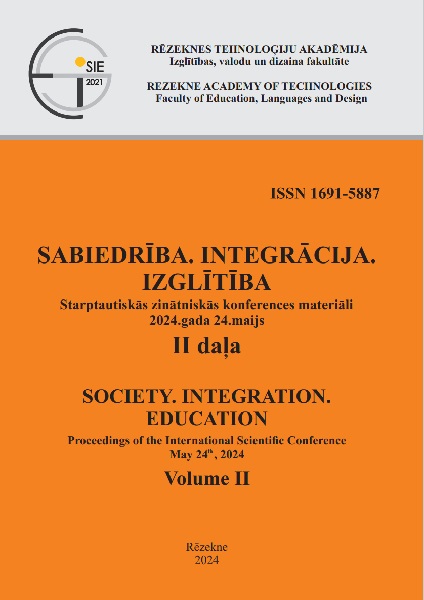RELATIONSHIP BETWEEN MOTIVATION OF CHILDREN AND YOUTH AND TIME SPENT IN FOOTBALL TRAINING (GRADE 5-9)
DOI:
https://doi.org/10.17770/sie2024vol2.7879Keywords:
football, motivation of children and youth for participation in football, time spent in football trainingAbstract
The laws and regulations of Latvia on the professional education activity in football training state that as the age of the students increases, the number of contact hours per week that must be spent in football training also increases. Furthermore, scientific literature often mentions that as people age, their motivation to engage in physical activity and sports often decreases. The aim of this study was to determine the relationship between the motivation of children and youth for participation and time spent in football training in different age groups. Within the framework of the study, the opinion of the Ethics Commission of the Latvian Academy of Sport Education was received on the compliance of the survey with ethical norms, as well as the legal representative of each research participant had confirmed their participation in the study with a permission. As part of the study, 167 research participants from one Latvian school were surveyed in the grade groups from 5 to 9. The number of hours the research participants spend in football training sessions per year was determined, as well as their motivation to participate in the training. The results of the study showed that as the age of children and youth increases, they spend more time in football training sessions (p≤0.001), but their motivation decreases every year (p≤0.01).
References
Audas, R., & Willms, J. D. (2002). Engagement and dropping out of school: A life-course perspective. Applied Research Branch, Human Resources Development Canada.
Bouchard, C., Blair, S. N., & Haskell, W. L. (2012). Physical activity and health. Human Kinetics.
Caspersen, C.J., Powell, K.E., & Christenson, G.M. (1985). Physical activity, exercise, and physical fitness: definitions and distinctions for health-related research. Public Health Reports, 100(2), 126.
СMRL. (2021). Procedures by which the State Finances Vocational Orientation Sports Education Programmes. Regulations of the Cabinet of Ministers of the Republic of Latvia No. 885. Retrieved from: https://likumi.lv/ta/en/en/id/328709-procedures-by-which-the-state-finances-vocational-orientation-sports-education-programmes
Cope, E.J., Bailey, R., & Pearce, G. (2013). Why do children take part in, and remain involved in sport? A literature review and discussion of implications for sports coaches. International Journal of Coaching Science, 7(1), 55-74.
Cresswell, J., Rogers, C., Halvorsen, J., & Bonfield, S. (2019). Ideal football culture: A cultural take on self‐determination theory. Journal for the Theory of Social Behaviour, 49(2), 198-211.
Dvorak, J. (2004). Editorial. American Journal of Sports Medicine, 32(1), 3–4. DOI:10.1177/0363546503262283
Dvorak, J., Junge, A., Graf-Baumann, T., & Peterson, L. (2004). Football is the most popular sport worldwide. The American journal of sports medicine, 32(1). DOI: 10.1177/0363546503262283
Gulbe, A. (2010). Olimpiskās izglītības inovatīvs apguves modelis sporta pedagogu profesionālās kompetences pilnveidei. Promocijas darbs. Latvijas Sporta pedagoģijas akadēmija.
Hardman, A. E., & Stensel, D. J. (2009). Physical activity and health: the evidence explained. Routledge.
Izglītības un zinātnes ministrija (IZM) [MoES] (2014). Latvijas jauniešu sportošanas paradumi. Kvantitatīvas aptaujas rezultāti. Retrieved from: https://www.izm.gov.lv/lv/media/4069/download
Slimību profilakses un kontroles centrs [Centre for Disease Prevention and Control (CDPC)] (2023). Fizisko aktivitāšu ieteikumi Latvijas iedzīvotājiem. Retrieved from: https://www.spkc.gov.lv/lv/media/4747/download?attachment
Krastiņš, O. (1998). Statistika un ekonomoetrija. Rīga: LR Centrālās statistikas pārvaldes poligrāfijas nodaļa.
Latvijas Futbola federācija. [Latvian Football Federation]. (2018). Latvijas Futbola federācijas spēlētāju sagatavošanas programma. Rīga: LFF
Miller, B.W., Roberts, G.C., & Ommundsen, Y. (2004). Effect of motivational climate on sportspersonship among competitive youth male and female football players. Scandinavian Journal of Medicine & Science in Sports, 14(3), 193-202.
Morgan, S.W., Martin, L., Howard, B.J., & Mihalek, P.H. (2005). Active learning: what is it and why should I use it?. Developments in Business Simulation and Experiential Learning: Proceedings of the Annual ABSEL conference, 32, 219-223.
Robazza, C., Pellizzari, M., & Hanin, Y. (2004). Emotion self-regulation and athletic performance: An application of the IZOF model. Psychology of Sport and Exercise, 5(4), 379-404. https://doi.org/10.1016/S1469-0292(03)00034-7
Rodrigues, F., Monteiro, D., Matos, R., Jacinto, M., Antunes, R., & Amaro, N. (2023). Motivation among Teenage Football Players: A Longitudinal Investigation throughout a Competitive Season. European journal of investigation in health, psychology and education, 13(9), 1717–1727. https://doi.org/10.3390/ejihpe13090124
Ryan, R.M., & Deci, E.L. (2017). Self-determination theory: Basic psychological needs in motivation, development, and wellness. New York: Guilford publications.
Stults-Kolehmainen, M. A., Ciccolo, J. T., Bartholomew, J. B., Seifert, J., & Portman, R. S. (2013). Age and gender-related changes in exercise motivation among highly active individuals. Athletic Insight, 5(1), 45-63.
Vossoughi, S., & Bevan, B. (2014). Making and tinkering: A review of the literature. National Research Council Committee on Out of School Time STEM, 67, 1-55.
Willms, J.D. (2003). Student engagement at school: A sense of belonging and participation; Results from PISA 2000. Organisation for Economic Co-operation and Development.






